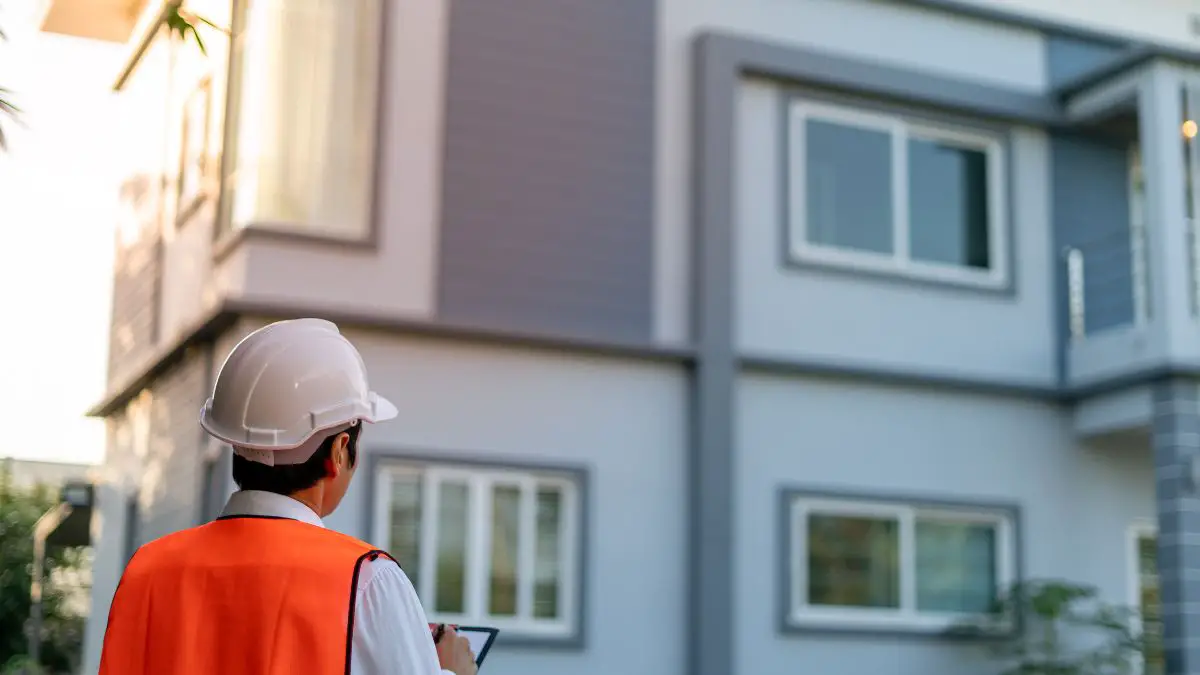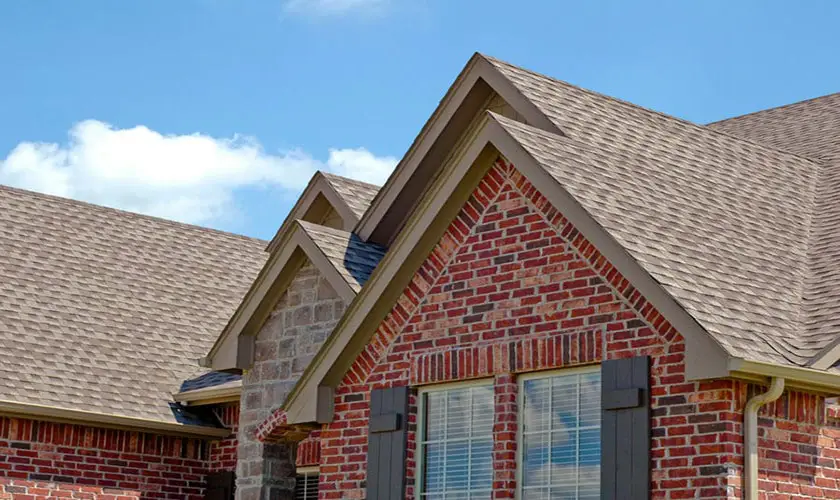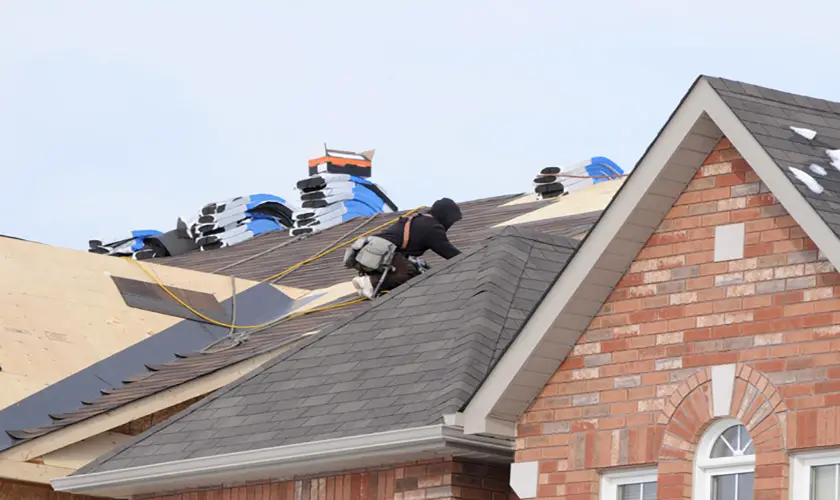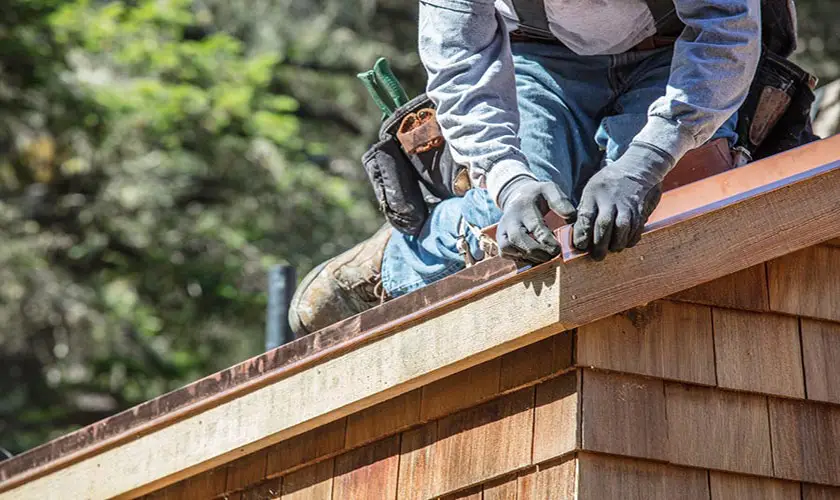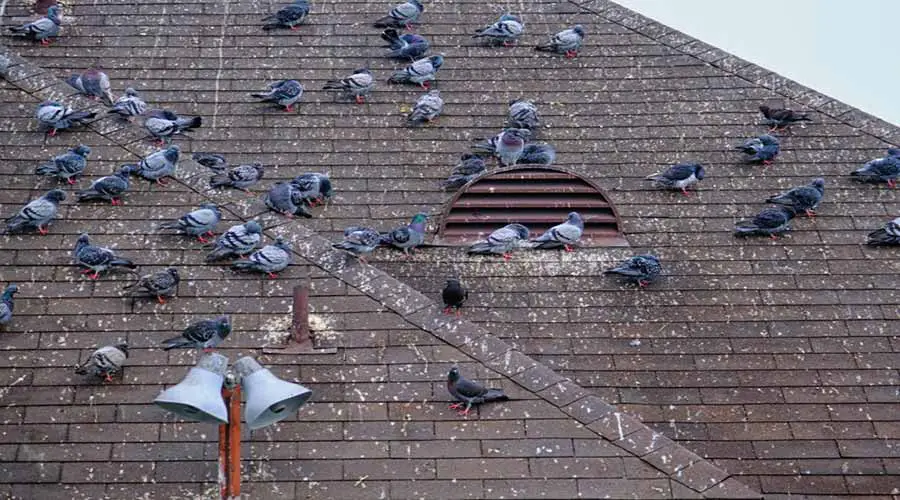
Pitch refers to the angle or slope of a roof. On one end of the spectrum is a flat roof, and on the other end is a steep roof pitch. If you’re wondering about the advantages and disadvantages of a steeply pitched roof, you’re in the right place!
A steep roof pitch allows water, snow, and debris to run off easily. Roofs with a less extreme pitch may suffer from issues caused by water or debris collection. While steeply pitched roofs are costly and not as trendy, they offer excellent curb appeal, durability, and additional interior space.
This article will break down everything you need to know about roof pitch and how it’s calculated. Once I’ve done that, we’ll take a more in-depth look at the advantages and disadvantages of a steeply pitched roof and whether or not it truly is the best choice for your situation.
Everything You Need to Know About Roof Pitch
When it comes to your roof, its pitch is only one characteristic–but it’s an important one! Essentially, the pitch of your roof refers to the slant or slope of your home’s roof. The steeper the roof’s pitch, the higher the roof will be, and the lower the pitch is, the flatter it will be.
Pitch is measured by looking at the vertical rise of your roof compared to the horizontal progression. The pitch of a roof is denoted as two figures in the format of X:Y. Here, X refers to how much the roof rises vertically in inches, and Y refers to how much the roof horizontally extends in inches.
A roof with a 6:12 pitch means that for every 6 inches of verticle rise, the roof also extends 12 inches horizontally. This allows you to calculate the angle of your roof. To do this, you can use a handy online calculator to calculate your pitch angle.
A roof with a 6:12 pitch has an angle of 26.57 degrees, allowing you to visualize its pitch and how steep it is. Luckily, you don’t need to get a pen and pencil out because the online pitch angle calculator will visualize it for you.
As a general rule of thumb, any roof with a pitch below 4:12 is considered a low roof pitch. Therefore, a roof with a pitch of 8:12 would be considered quite steep. In general, a 6:12 pitch is the most common.
The pitch of your roof plays an integral part in the overall functionality of your rooftop. There are many benefits in terms of different roof pitches. For example, flat roofs have more utility space on top of the roof, whereas a steeply pitched roof offers more interior storage space.
The pitch of your roof will also determine how your rooftop handles rainwater, snow, and debris. Therefore, it’s essential to consider the advantages and disadvantages of roofs with steep or low roof pitches.
| Steep Roof Pros | Steep Roof Cons |
|---|---|
| Debris, sticks, and branches slide right off | Climbing on a steeply pitched roof is dangerous |
| They shed water effectively and won’t pool on your roof | Your gutters will collect more debris and clog quickly |
| Much better design for snowy environments | Little to no usable rooftop space |
| They last a long time and are very durable | They can make your home appear older and less modern |
| Provides space for an extra room or storage area | Steeply pitched roofs can make attic rooms cramped |
| They open up lots of exterior decoration opportunities | They use more materials and is more expensive |
| Can make your home more energy-efficient | |
| They make your house stand out from the rest |
Which level of roof pitch you end up choosing for your home largely depends on your area, design, preferences, and needs. Make sure to take the time to weigh your options properly so you end up with a design that you enjoy.
The Advantages of a Steep Roof Pitch
There are many benefits to a steeply pitched roof, so in the following sections, I’ll list them out and take a deeper look at each one so you can factor them into your final decision.
1. Your Roof Will Be Free of Debris
By having a steeply pitched roof, your roof will generally be free of debris that typically piles up on rooftops. Branches, twigs, leaves, and other debris get blown off by the wind. While this may seem like a minor benefit, you’ll be thankful for your steep roof pitch when a storm begins.
When debris collects on flat roofs or ones with a low slope, you’re more likely to develop leaks. When debris gathers on low-pitched roofs, the flow of rainwater can be interrupted, which can lead to pooling water. Both of these things could lead to costly roof repairs down the line.
2. You Won’t Need to Worry About Pooling Water
This benefit goes hand in hand with the one mentioned above. Even if a flat roof was completely clear of debris, water still can collect on the rooftop. This can result in a leak developing, which could be a disastrous inconvenience when it’s raining.
If you live in a region with above-average to heavy rainfall, having a roof with a steep pitch will allow water to run down your roof to your gutters easily. With a steeply pitched roof, gravity is always on your side, even in the snow.
3. It’s Better for Snowy Environments
Snow, like rainfall, can lead to pooling water on low-pitched roofs. Snow and ice are known to force moisture into the roofs of houses when it collects. With a steeply pitched roof, snow will slide off your rooftop before it can cause expensive damage to your home.
A steeply pitched roof should be considered a must for those who live in regions with harsh winters. With a low-pitched roof pitch in that type of environment, you’re signing up for an endless struggle during the winter months.
4. It’s the More Durable Option
As mentioned above, roofs with low slopes are more likely to collect pooling rainwater or snow. In turn, this can lead to roof damage and various issues linked to that. Roofs with steep pitches, however, prevent many of these issues.
This means that, by investing in a roof with a steep pitch, you’re getting a roof that will be more durable than other roofing options. Not only will your roof have a longer lifespan, but you’ll also save money on unnecessary rooftop repairs.
5. It Doubles as a Extra Room or Storage Space
One of the other significant benefits of having a steeply pitched roof is the sheer space it offers you! Houses with steep roof pitches have more storage space in their attics. This is great for long-term storage of things that would otherwise clutter your home.
If you have a steeply pitched roof but no attic, adding an attic space costs much less than you might expect because the necessary space is already there. There is no need to extend your home or roof; construct an attic, and you’re all set.
Depending on just how steep your roof’s pitch is, the space can be even more than just mere storage. There’s no shortage of inspiration when it comes to using the space under a steeply pitched roof. You can make it into a game roof, extra bedroom, or just a cool hang-out room.
6. More Exterior Decoration Possibilities
With a steeply pitched roof, you have more decorative options available to you. Just think of the endless possibilities during the festive season! Putting lots of strong lights along the edge of a steep roof can be pretty festive and breathtaking.
A steeply pitched roof introduces new and exciting ways to decorate your home’s exterior, from the gables to decorative caps. There are nearly endless possibilities.
7. It Can Help You Become More Energy Efficient
When your home has a roof with a steep pitch, you can install a cold roof system within your home. Having a home with a steeply pitched roof is one of the necessities for this system, which can prevent water damage to your roof and the underlying structure.
Hot air rises and, in a snowy environment, this heat cause snow and ice to melt and refreeze. This has the potential to damage your roof, as mentioned above. Cold roof systems keep the roof cold so that snow does not melt and refreeze.
In warm regions, a cold roof system can decrease cooling costs. This, in turn, helps you become more energy efficient. That money saved on cooling costs also won’t hurt!
8. Your Home Will Stand Out
The last advantage is one you’ll spot as you’re driving down your road towards your house. Steeply pitched roofs are known to catch the eye, boosting the overall curb appeal of your home.
A steeply pitched roof will help your home stand out among the many other similar-looking houses and can increase your property’s value.
The Disadvantages of a Steep Roof Pitch
While there are plenty of advantages to having a steeply pitched roof, there are some disadvantages to consider. Keep reading as we take a more in-depth look at each and break them down for you.
1. They Can Be More Dangerous
Your roof can get unintentionally damaged, regardless of its pitch. A rogue tree branch could damage your roof on a windy day, for example. When it comes down to getting onto the roof to assess the damage, however, there’s a higher safety risk with a steeply pitched roof.
While it’ll be easier to assess your rooftop from ground level when your roof has an extreme pitch, extra caution will need to be taken when climbing onto your roof to assess it for any damage.
2. Your Gutters Will Get Clogged Faster
Another disadvantage of having a steeply pitched roof is that you’ll need to clean your gutters more frequently. While a steeply pitched roof is fantastic for preventing debris buildup on your rooftop, a lot of this debris gets stuck in your gutters as it slides off your roof.
When your gutters are clogged, the flow of rainwater is restricted. This could result in a variety of plumbing issues that will be costly to fix. However, if you make a point of routinely ensuring your gutters are clean, you have nothing to worry about in this regard.
3. You’ll Have Less Rooftop Utility Space
While steeply pitched roofs are great for additional interior space, they diminish the exterior utility space a flat roof provides. Flat roofs can often be used to store tools or provide easy access to air conditioning units. Many people have enev converted their flat rooftop space as an outside entertainment space.
If you get a steeply pitched roof, you forfeit the utility space a flat roof could offer. Conversely, if you opt for a flat roof, you lose additional interior space. Ultimately, you’ll have to decide which is more important to you!
4. The Design is Less Modern
In terms of design aesthetic, flat roofs are considered more modern than roofs with steep pitches. In perspective, steeply pitched roofs can associate with older architectural styles, such as Tudor homes.
If you’re concerned about your home’s exterior aesthetic, specifically how modern your home appears, this is an aspect you may want to keep in mind.
5. Steep Roofs Alter Interior Space
This con depends on the exact specifications of your home and will not apply to every home. However, when a roof has a steep pitch, interior space is affected. If you’re using the pitched space for storage space, this likely won’t bother you one bit!
However, if you want to utilize the space your steeply pitched roof offers as a functional area, such as a bedroom on the top floor, the size of the space is negatively impacted by the pitch of the roof.
6. It Will Cost More to Install
Typically, steeply pitched roofs are more expensive to get installed than a flat roof. The reason for this is simple: the lower the pitch of a roof, the fewer materials you’ll need to construct it. However, the higher cost could be worth it if the advantages discussed earlier appealed to you!
Is a Steep Roof Pitch Better?
There are many benefits to having a steeply pitched roof, but is it truly the better option when compared to roofs with a lower pitch? It depends on various factors, such as your unique needs in your home and the type of climatic region you reside.
As discussed earlier in this article, steeply pitched roofs allow rain, water, and debris to run off your roof. This prevents many common rooftop issues. While your gutters may need to be cleaned more regularly, your rooftop’s lifespan will be increased!
Therefore, a steeply pitched roof is ideal for those who live in cold regions with harsh winters. Steeply pitched roofs also allow for cold roof systems to be installed within homes. While these systems should be considered a necessity for homes in colder climates, they also offer advantages for homes in hot regions.
While a steeply pitched roof won’t offer any utility space on top of your roof, it will provide you with additional storage space within your home. This can be a great way to keep your home free of unnecessary clutter.
Steeply pitched roofs are not only highly functional but they’re known to catch the eye as well. While some consider steep roofs less modern, these roofs will instantly increase the curb appeal of your home. Overall, there are many great benefits to a steeply pitched roof.
In many instances, you will come to find that a steeply pitched roof is the better option. However, that ultimately depends on your needs. Now that you have a better understanding of the advantages and disadvantages of a steeply pitched roof, you’re ready to make your decision!
Conclusion
In this article, we looked at the pitch of a roof, how it’s calculated, and why it matters. The pitch of your roof can offer many advantages and disadvantages.
Therefore, it’s essential to understand all the pros and cons of a particular roof type–such as the steeply pitched roof we looked at–before you make your decision on which roof pitch is the best for you and your needs.



